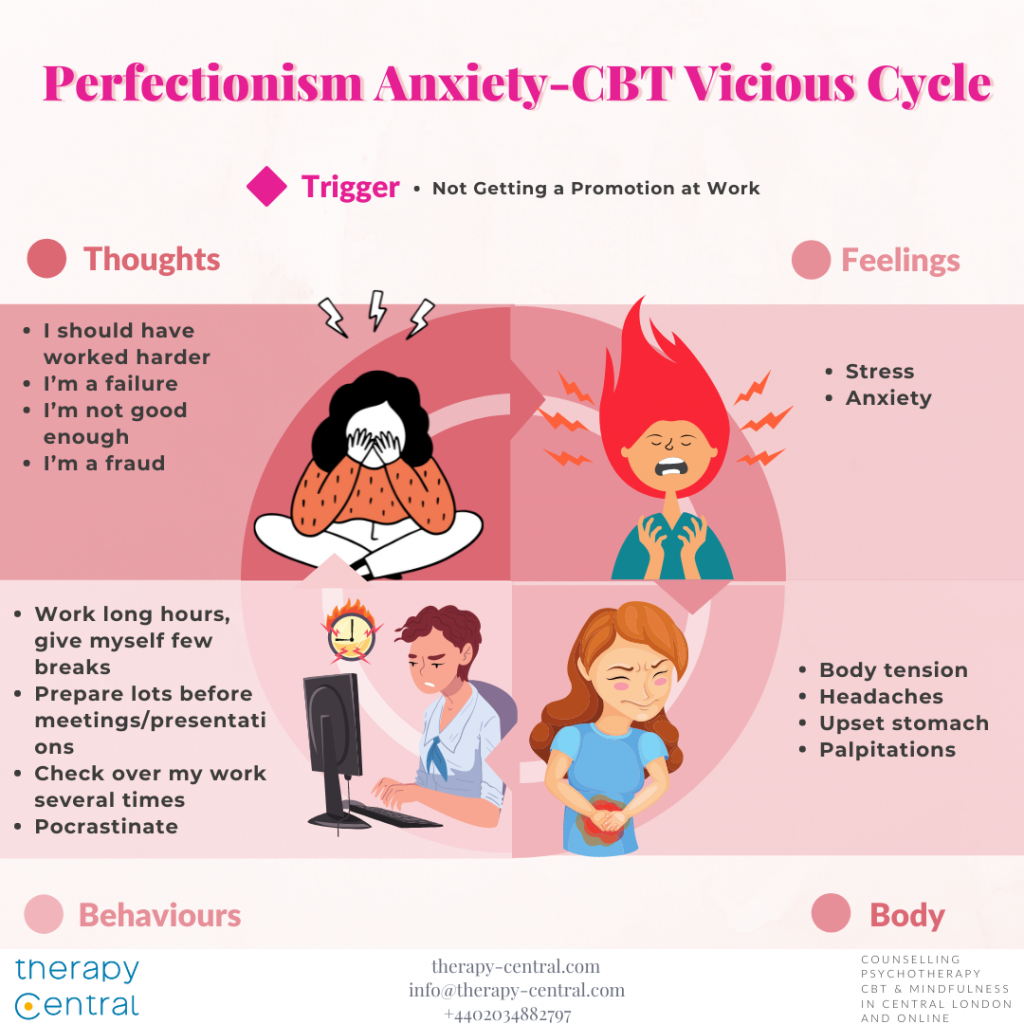Perfectionism and anxiety often go hand in hand. They create a cycle that's hard to break.
Perfectionism pushes you to set unattainable standards. When you fail to meet them, anxiety creeps in. This cycle can affect your mental health and daily life. It can make you feel overwhelmed and stuck. Understanding this link is key to finding relief.
Breaking free from this cycle is not easy, but it is possible. You can learn to manage both perfectionism and anxiety. This post will explore practical steps to help you do just that. By recognizing the signs and making small changes, you can improve your well-being. Let’s dive into how you can break the cycle and find peace.
Perfectionism And Its Impact
Perfectionism and anxiety often go hand in hand. Many strive for flawlessness. This relentless pursuit can harm mental health. Understanding how perfectionism affects us can help break this cycle.
Defining Perfectionism
Perfectionism is the desire to be perfect. It involves setting high standards. People who are perfectionists are never satisfied with their efforts. They see mistakes as failures. This mindset can be exhausting and stressful.
Effects On Mental Health
Perfectionism can lead to anxiety. The constant pressure to be perfect causes worry. It can also result in depression. Feelings of failure and worthlessness increase. It can affect self-esteem. Perfectionists often feel they are never good enough. This can create a cycle of negative thoughts.
Perfectionism can harm physical health too. Stress from perfectionism can lead to headaches. It can cause sleep problems. It can also affect relationships. Perfectionists may be critical of others. This can lead to conflicts and isolation.

Credit: therapy-central.com
Understanding Anxiety
Perfectionism often goes hand in hand with anxiety. Many strive for flawlessness, fearing mistakes. This fear can lead to intense anxiety.
Understanding anxiety is crucial. It helps to identify and manage the symptoms. Let's explore the symptoms and common triggers of anxiety.
Symptoms Of Anxiety
Anxiety manifests in various ways. Common symptoms include excessive worrying, restlessness, and irritability. Some people experience physical symptoms like sweating, trembling, and rapid heartbeat. Others may have trouble sleeping or concentrating.
Recognizing these symptoms is the first step. It helps to take action and seek help.
Common Triggers
Several factors can trigger anxiety. Stressful situations, such as work pressure or personal conflicts, are common triggers. Unrealistic expectations and fear of failure can also cause anxiety. Social situations, like public speaking or meeting new people, may trigger anxious feelings.
Identifying your triggers is essential. It helps to manage and reduce anxiety effectively.
The Cycle Of Perfectionism And Anxiety
Perfectionism and anxiety often go hand in hand. People striving for perfection can feel overwhelmed. They may believe that anything less than perfect is a failure. This mindset creates a cycle that can be hard to break. Understanding how these two feed off each other is crucial.
How They Feed Each Other
Perfectionists set high standards for themselves. These standards can be unrealistic. When they fail to meet these goals, anxiety sets in. This anxiety then drives them to try even harder. The cycle continues, causing more stress and worry.
Perfectionism also leads to procrastination. People may put off tasks out of fear. They fear that the final product won't be perfect. This delay increases anxiety. As deadlines approach, stress levels rise. The result is a never-ending loop.
Negative Thought Patterns
Negative thoughts play a big role in this cycle. Perfectionists often engage in all-or-nothing thinking. They see things in black and white. This mindset leaves no room for mistakes. Any error becomes a complete failure in their eyes.
Another common thought pattern is catastrophizing. Perfectionists imagine the worst-case scenario. They believe that one mistake will lead to disaster. These thoughts increase anxiety. The fear of failure becomes paralyzing. Breaking these patterns is essential for reducing anxiety.
Perfectionists also engage in self-criticism. They are often their harshest critics. This constant self-judgment wears them down. It fuels anxiety and lowers self-esteem. Recognizing these negative thoughts is the first step to change.
Recognizing Perfectionist Tendencies
Perfectionism can often lead to a cycle of anxiety and stress. Recognizing perfectionist tendencies is the first step to breaking free. Understanding these tendencies can help you address harmful behaviors and find healthier ways to cope.
Self-assessment Techniques
Self-assessment techniques can help you identify perfectionist tendencies. Reflect on your thoughts and behaviors. Do you set unrealistically high standards for yourself? Do you fear failure or criticize yourself harshly? Write down your thoughts and feelings. This can help you see patterns.
Journaling is another useful tool. Keep track of moments when you feel stressed. Note what triggered these feelings. This can provide insights into your perfectionist tendencies.
Identifying Harmful Behaviors
Identifying harmful behaviors is crucial in managing perfectionism. Do you procrastinate because you fear your work won't be perfect? Do you spend too much time on small details? Recognizing these behaviors is important.
Pay attention to how you talk to yourself. Are you overly critical? Negative self-talk can increase anxiety. Try to replace these thoughts with kinder, more realistic ones.
Ask for feedback from friends or family. They can help you see behaviors you might miss. This outside perspective can be very valuable.
Strategies To Break The Cycle
Perfectionism and anxiety often feed off each other, creating a difficult cycle. To break this cycle, adopting effective strategies is crucial. Various techniques can help manage these intertwined issues. Below, we explore some practical strategies.
Cognitive Behavioral Techniques
Cognitive Behavioral Techniques (CBT) can help change negative thought patterns. Identifying irrational thoughts is the first step. Ask yourself: Is this thought realistic? Challenge these thoughts with factual evidence. Replace them with more balanced thoughts. Over time, these new patterns will form.
Behavioral changes are also important. Gradually expose yourself to situations that trigger anxiety. Start small and work your way up. This helps build confidence and reduces fear. Consistent practice makes these techniques more effective.
Mindfulness Practices
Mindfulness practices focus on staying present in the moment. This reduces the constant worry about perfection. One simple technique is deep breathing. Take slow, deep breaths to calm your mind. This can be done anywhere, anytime.
Meditation is another powerful tool. Spend a few minutes each day meditating. Focus on your breath and let go of intrusive thoughts. This practice can significantly reduce anxiety over time.
Yoga combines physical movement with mindfulness. Regular practice can improve both mental and physical well-being. Even short sessions can make a difference.
Building Resilience
Perfectionism and anxiety often go hand in hand. The desire for flawlessness can be overwhelming. This creates a cycle that is hard to break. Building resilience is key to escaping this trap. It helps you deal with setbacks and reduces anxiety. Let's explore ways to build resilience.
Developing Self-compassion
Self-compassion means being kind to yourself. Treat yourself as you would a friend. This can reduce perfectionism and anxiety. Self-compassion involves:
- Acknowledging your flaws.
- Forgiving yourself for mistakes.
- Encouraging positive self-talk.
Practice self-compassion daily. This builds emotional strength.
Setting Realistic Goals
Setting goals that are too high can increase anxiety. Aim for realistic goals. Break tasks into smaller steps. This makes them manageable. Here’s how to set realistic goals:
| Strategy | Action |
|---|---|
| Assess your abilities | Know your limits and strengths. |
| Prioritize tasks | Focus on what’s most important. |
| Set deadlines | Give yourself reasonable time frames. |
Review your goals regularly. Adjust them as needed. This keeps your anxiety in check.
Seeking Professional Help
Perfectionism and anxiety often go hand in hand. They can create a vicious cycle. Breaking this cycle can seem daunting. One effective step is seeking professional help. Professional help can provide tools and strategies. It can offer support and guidance.
Therapeutic Approaches
Therapists use various approaches to treat perfectionism and anxiety. Cognitive Behavioral Therapy (CBT) is one common method. CBT helps identify and change negative thought patterns. It teaches coping skills and stress management techniques.
Another approach is Acceptance and Commitment Therapy (ACT). ACT focuses on accepting thoughts and feelings. It encourages commitment to personal values. This can help reduce the stress that fuels perfectionism.
Mindfulness-Based Therapy is also effective. It promotes awareness of the present moment. This can reduce anxiety and help manage perfectionist tendencies.
Finding The Right Therapist
Finding the right therapist is crucial. Start by researching therapists who specialize in anxiety and perfectionism. Look for credentials and experience. Reviews and testimonials can provide insight into their effectiveness.
Consider your comfort level with the therapist. A good connection can enhance therapy outcomes. Initial consultations can help determine compatibility. Don't hesitate to ask questions about their approach and experience.
Professional help can make a significant difference. It can provide the tools to break the cycle. Take the first step towards a healthier mindset. Seek the support you need.

Credit: creatingmaryshome.com
Thriving Beyond Perfectionism
Break the cycle of perfectionism and anxiety by embracing imperfection. Small steps and self-compassion lead to a healthier mindset.
Perfectionism often leads to anxiety and stress. It creates a cycle that is hard to break. But, it is possible to thrive beyond perfectionism. By embracing imperfection and cultivating a growth mindset, you can find peace and joy.Embracing Imperfection
Perfection is an illusion. No one is perfect. Accepting this truth brings freedom. It allows you to focus on what truly matters. Start by setting realistic goals. Understand that mistakes are part of growth. They do not define your worth. Celebrate small wins. Learn to laugh at your errors. It reduces stress and anxiety.Cultivating A Growth Mindset
A growth mindset means believing in your ability to improve. It means seeing challenges as opportunities. Not as threats. Embrace learning. Focus on progress, not perfection. Celebrate effort, not just results. This mindset shift can reduce anxiety. It promotes resilience and optimism. Surround yourself with supportive people. They can encourage your growth. Remember, it's about progress, not perfection. ```
Credit: mpowerminds.com
Frequently Asked Questions
What Is The Link Between Perfectionism And Anxiety?
Perfectionism often leads to anxiety as individuals set unattainable standards. This creates constant stress and fear of failure. Over time, this stress can develop into anxiety disorders.
How Can Perfectionism Cause Anxiety?
Perfectionism causes anxiety by creating unrealistic expectations. When these expectations are not met, it leads to stress, self-criticism, and worry. This constant cycle increases anxiety levels.
What Are The Signs Of Perfectionism-related Anxiety?
Signs include excessive worry, fear of making mistakes, procrastination, and difficulty relaxing. Individuals often feel overwhelmed by their own high standards.
How Can I Break The Perfectionism-anxiety Cycle?
To break the cycle, set realistic goals, practice self-compassion, and seek support. Mindfulness and cognitive behavioral therapy can also help manage perfectionism and reduce anxiety.
Conclusion
Breaking the cycle of perfectionism and anxiety is possible. Start small. Focus on progress, not perfection. Remember, nobody is perfect. Embrace mistakes as learning opportunities. Practice self-compassion daily. Set realistic goals for yourself. Celebrate your achievements, no matter how small.
Seek support from friends or a therapist. Take care of your mental health. You deserve peace and happiness. Keep moving forward, one step at a time. Your journey to a calmer mind begins today.






